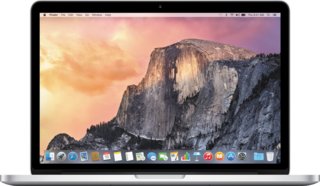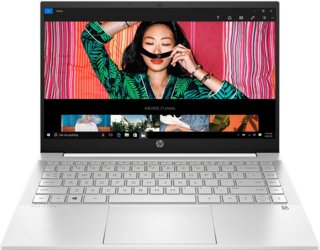Apple MacBook Pro (2015) 13" vs HP Pavilion (2021) 14" Intel Core i5-1135G7
Explore high-performance computing in this friendly comparison between the respected Apple MacBook Pro (2015) 13" and the durable HP Pavilion (2021) 14" Intel Core i5-1135G7. We intend to clarify their pros and cons, focusing on key features like design, durability, and task suitability. Whether you're a digital nomad in need of a trustworthy ally or a casual user searching for a reliable machine, we're prepared to assist. Let's examine the details that set these two well-liked choices apart in the laptop market. Keep in mind, each has its unique appeal—we’re here to help you decide which one suits your tech preferences perfectly!
System and application performance
Performance in popular 3D games
Viewing angle, color accuracy...
Ports, webcam and other interfaces
Potential battery life
Materials, durability and portability
Design Comparison
Size Comparison
Design Comparison: Apple MacBook Pro (2015) 13" vs. HP Pavilion (2021) 14"
Weight and Dimensions
- The Apple MacBook Pro (2015) weighs 3.5 pounds, whereas the HP Pavilion (2021) is lighter at 3.1 pounds, making it more portable without sacrificing screen size.
- Both laptops are equally thin, measuring 0.7 inches thick, enhancing their sleek and modern design.
Keyboard and Input Features
- Both laptops have backlit keyboards, providing convenience in dimly lit settings to improve the user experience.
- HP Pavilion now offers a fingerprint scanner for secure login, enhancing functionality and security beyond that of the Apple MacBook Pro.
Connectivity Ports
- The HP Pavilion offers an extra USB port compared to the MacBook Pro, giving users additional choices for connecting peripherals. The HP Pavilion's inclusion of USB Type-C brings versatility through faster data transfer and charging options compared to the older MacBook Pro model.
Display Size and Quality
The HP Pavilion features a 14-inch screen, which is larger than the 13.3-inch display found on the MacBook Pro. This could be ideal for users who value more screen space for work or entertainment purposes.
- Both laptops come with HDMI ports for connecting to external displays, adding versatility to their usage.
Wireless Connectivity and Audio Features
- The Wi-Fi versions on both laptops ensure seamless wireless connectivity, with the HP Pavilion supporting the latest Wi-Fi 6 standard for enhanced performance.
- Stereo speakers on both devices deliver quality audio output for multimedia consumption or video calls, enhancing user experience in various scenarios.
Camera and Microphone Setup
- Both laptops feature front cameras and dual microphones, facilitating clear video calls or online meetings with quality audio input.
- Voice command support on the HP Pavilion provides added convenience for hands-free operation, catering to users seeking efficient interaction with their devices.
User Experience Insights:
Students: The lightweight design of the HP Pavilion coupled with its larger screen size may appeal to students looking for a balance between portability and productivity.
Professionals: The security-enhancing features like the fingerprint scanner on the HP Pavilion can benefit professionals handling sensitive information or requiring quick access to their devices securely.
Conclusion:
The Apple MacBook Pro (2015) sticks to its iconic design, while the HP Pavilion (2021) brings new features like a fingerprint scanner and fast Wi-Fi support for today's tech needs. If you prioritize updated security and better connectivity, the HP Pavilion might be your pick. But if you prefer the classic look, the MacBook Pro holds its charm.
Screen Comparison
| Apple MacBook Pro (2015) 13" | HP Pavilion (2021) 14" Intel Core i5-1135G7 | |
|---|---|---|
| Resolution | QHD | Full HD |
| Screen Size | 13.3" | 14" |
Let's compare the screen features of the Apple MacBook Pro (2015) 13" and the HP Pavilion (2021) 14" Intel Core i5-1135G7 to understand how they differ and influence your viewing experience. We'll explore aspects like resolution, screen size, and display technology in this comparison.
Screen Resolution:
- Apple MacBook Pro (2015) 13":
- Resolution: 2560 x 1440 px
- Pixel Density: 227 ppi
- HP Pavilion (2021) 14":
- Resolution: 1920 x 1080 px
- Pixel Density: 157 ppi
Comparison: The MacBook Pro offers a superior resolution and pixel density in comparison to the HP Pavilion. As a result, images and text will appear sharper and more detailed on the MacBook Pro because of its higher pixel count.
Screen Size:
- Apple MacBook Pro (2015) 13":
- Screen Size: 13.3 inches
- HP Pavilion (2021) 14":
- Screen Size: 14 inches
Comparison: The HP Pavilion features a slightly bigger screen than the MacBook Pro, providing additional space for multitasking or enjoying multimedia content.
Display Technology:
- Apple MacBook Pro (2015) 13":
- Display Type: IPS, LCD, LED-backlit
- Anti Reflection Coating: True
- Supported Displays: 3
- HP Pavilion (2021) 14":
- Display Type: IPS, LCD, LED-backlit
- Brightness: 250 nits
- Anti Reflection Coating: True
- Supported Displays: 4
Comparison: Both laptops use IPS technology to improve color accuracy and widen viewing angles. The anti-glare coating on both screens minimizes reflections in well-lit environments. The HP Pavilion provides a higher brightness level, offering an advantage in bright settings.
Practical Implications:
- Gaming: An Apple MacBook Pro boasts a high-resolution screen that enhances the gaming experience with vivid graphics and detailed visuals. On the other hand, the HP Pavilion's larger display provides a broader view for an engaging gameplay experience.
- Professional Graphic Design: The MacBook Pro's high pixel density display is perfect for intricate graphic design and photo editing tasks. Conversely, the HP Pavilion's brighter screen is advantageous for color-sensitive work in different lighting environments.
In conclusion, the Apple MacBook Pro stands out for its high resolution and pixel density, making it ideal for detailed tasks. On the other hand, the HP Pavilion boasts a larger screen size and brighter display, which are beneficial in various lighting conditions. Your decision between these laptops will be based on your unique requirements for visual quality and usability in different situations.
Hardware Comparison
| Apple MacBook Pro (2015) 13" | HP Pavilion (2021) 14" Intel Core i5-1135G7 | |
|---|---|---|
| RAM | 8GB | 16GB |
| Storage Size | 1000GB | 512GB |
In comparing the hardware features of the Apple MacBook Pro (2015) 13" and the HP Pavilion (2021) 14" Intel Core i5-1135G7 2.4GHz / 16GB RAM / 512GB SSD, certain components significantly influence real-world performance.
Apple MacBook Pro (2015) 13
- CPU: The MacBook Pro released in 2015 is equipped with a 2GHz processor boasting 4 threads. It also includes Flash storage and operates on a 14nm semiconductor size.
- RAM: The device features 8GB of RAM running at 1866MHz, with support for a maximum memory capacity of 16GB.
HP Pavilion (2021) 14" Intel Core i5-1135G7
- CPU: The HP Pavilion features an Intel Core i5-1135G7 processor running at 2.4GHz, delivering increased performance capabilities.
- RAM: The Pavilion boasts an impressive 16GB DDR4 RAM operating at high speeds of 4267MHz, delivering enhanced multitasking capabilities and overall performance.
Practical Performance Impact:
- Multimedia Tasks: The HP Pavilion's superior CPU and RAM specifications make it better suited for handling demanding multimedia tasks like video editing or graphic design software efficiently compared to the older MacBook Pro.
- Heavy Software Operation: For heavy software operation such as running virtual machines or complex simulations, the higher clock speed and core count of the HP Pavilion's CPU combined with faster RAM provide a substantial performance boost over the MacBook Pro.
In summary, while the Apple MacBook Pro (2015) has been a reliable workhorse for its time, the HP Pavilion (2021) offers significant upgrades in CPU power and memory capacity that translate into smoother performance across various applications. If you prioritize multitasking, multimedia work, or heavy software usage, the HP Pavilion would be a more suitable choice due to its improved hardware specifications.
Verdict
Why Apple MacBook Pro (2015) 13"?
- Superior screen resolution and pixel density for detailed tasks.
- Timeless design with an iconic appeal.
- Quality build and durability associated with Apple products.
Why ?
- The HP Pavilion (2021) features a more modern Intel Core i5-1135G7 processor, offering increased performance capabilities.
- The HP Pavilion provides superior multitasking abilities and smoother performance for demanding multimedia tasks with its 16GB DDR4 RAM operating at high speeds.
- The HP Pavilion's larger 14-inch screen size offers more space for multitasking and enjoying multimedia content.
- The HP Pavilion's inclusion of a fingerprint scanner and support for fast Wi-Fi 6 enhances security and connectivity features compared to the older MacBook Pro model.
Similar comparisons
- Apple MacBook Pro (2015) 13" vs HP Envy x360 15 15.6" Intel Core i7-4510U
- Apple MacBook Pro (2015) 13" vs HP Envy 13 13.3" Intel Core i5-7200U
- Apple MacBook Pro (2015) 13" vs Apple MacBook Pro (2017) 13" with Touch Bar and Touch ID / Intel Core i5 256GB
- Apple MacBook Pro 16" Intel Core i7 vs Apple MacBook Pro 16" Intel Core i9
- Apple MacBook Pro 16" Intel Core i7 vs HP EliteBook 850 G7 15.6" Intel Core i7-10510U

